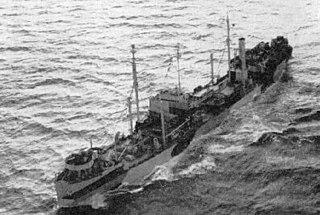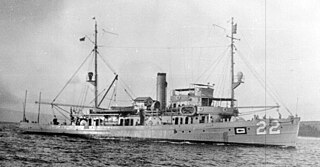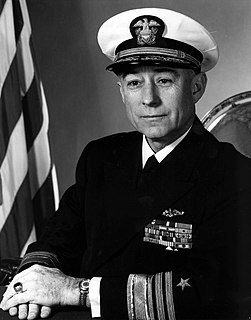
USS Lamberton (DD-119)/(DMS-2) was a Wickes-class destroyer in the United States Navy in commission from 1918 to 1922 and from 1930 to 1946. She saw service during World War II. She was the only ship named for Benjamin P. Lamberton, a rear admiral who served with Admiral Dewey in the Battle of Manila Bay in 1898 during the Spanish–American War.
USS Pocahontas (YT-266/YTB-266/YTM-266) was a type V2-ME-A1 Hiawatha-class yard tug in the United States Navy during World War II.

Admiral Jonas Howard Ingram was an officer in the United States Navy during World War I and World War II. He commanded the United States Atlantic Fleet during World War II and was a recipient of the Medal of Honor for his actions in 1914 in Veracruz, Mexico.

USS Brazos (AO-4) was an Kanawha-class fleet oiler built during World War I for service in the United States Navy, and named for the Brazos River, the longest river in the State of Texas.

USS Norris (DD-859) was one of 98 Gearing-class destroyers in the United States Navy during the end of World War II. Norris was active from 9 June 1945 to 4 December 1970. Although built too late to see action during the war, the ship served in the Pacific, Atlantic, Asiatic, and Mediterranean areas.

USS LST-310 was one of 390 tank landing ships (LSTs) built for the United States Navy during World War II.

USS Widgeon (AM-22/ASR-1) was an Lapwing-class minesweeper acquired by the United States Navy for the dangerous task of removing mines from minefields laid in the water to prevent ships from passing. Later converted to a submarine rescue ship. Widgeon was named by the Navy after the widgeon, a freshwater duck.

USS Black Hawk (AD-9) was a destroyer tender.

USS Salem (CM-11) was a commercial cargo ship, that served as a minelayer and then net laying ship of the United States Navy during World War II.

USS Falgout (DE-/DER-324) was an Edsall-class destroyer escort built for the U.S. Navy during World War II. She served in the Atlantic Ocean and provided destroyer escort protection against submarine and air attack for Navy vessels and convoys. Post-war, she was borrowed by the U.S. Coast Guard and also served as a radar picket ship on the Distant Early Warning Line. She was reclassified DER-324 on 28 October 1954.

USS Sterope (AK-96) was an Crater-class cargo ship commissioned by the U.S. Navy for service in World War II. She was responsible for delivering troops, goods and equipment to locations in the war zone.

USS Bullock (AK-165) was an Alamosa-class cargo ship commissioned by the U.S. Navy for service in World War II. She was responsible for delivering troops, goods and equipment to locations in the war zone.

The second USS Uncas was a United States Navy tug in commission from 1898 to 1922.

USS Jack C. Robinson (APD-72), ex-DE-671, was a United States Navy high-speed transport in commission from 1945 to 1946.

Bernard Lige Austin was a Vice Admiral of the United States Navy. His career included service in World War II, the Korean War, and the Cold War and command of submarines and surface ship forces, during which he became a distinguished combat commander of destroyers. He also commanded the United States Second Fleet, held numerous diplomatic, educational, and administrative staff positions, and a served a lengthy tour of duty as President of the Naval War College.
USS Pontus was a Motor Torpedo Boat Tender in service with the United States Navy during the Second World War. Commissioned in March 1943, during the war she was assigned to the Asiatic-Pacific Theater.
Modoc was a steam tug, built in 1890 as the commercial tug Enterprise, in service with the United States Navy from 1898 to 1947. The tug had been assigned the hull number YT‑16 in 1920. When the name Modoc was cancelled 5 October 1942 the tug became the unnamed YT‑16 until reclassified in 1944 to become YTL-16. The tug served for 49 years and in both World War I and World War II before being transferred to the Maritime Commission in early 1947 for disposal.

USS Blackford (APB-45) was a Benewah-class self-propelled barracks ship that was in service with the United States Navy during the waning days of World War II. She was decommissioned in April 1947 and sold for merchant service. In c. 1968-1970, she was sunk as a target by the South African Military.
USS LST-717 was a LST-542-class tank landing ship in the United States Navy during World War II. She was transferred to the Republic of China Navy as ROCS Chung Yeh.
USS LST-308 was a LST-1-class tank landing ship in the United States Navy during World War II.














